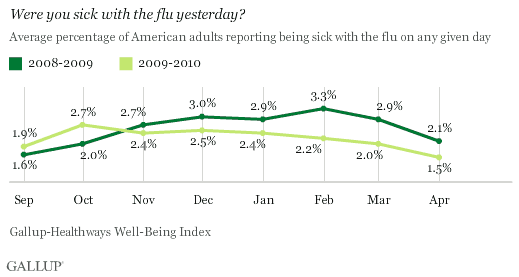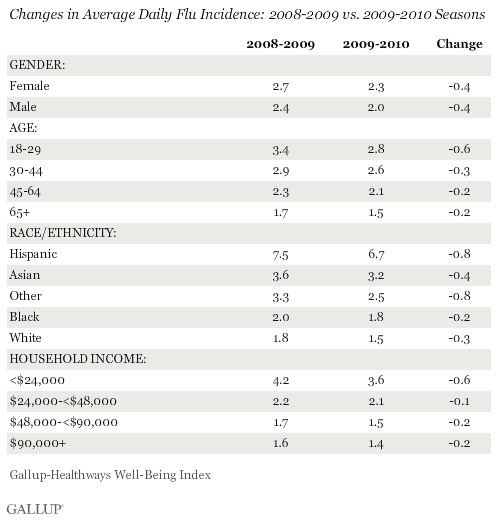WASHINGTON, D.C. -- Despite initial concerns about the rampant spread of H1N1 heading into the 2009-2010 cold and flu season, flu reports have been consistently lower throughout this flu season compared with the last according to the Gallup-Healthways Well-Being Index. April marks the sixth consecutive month in which fewer American adults in Gallup's tracking have reported having the flu the prior day compared with the corresponding months' estimates from one year ago.

By asking 1,000 Americans each day whether they had the flu "yesterday," the data provide a clear picture of the prevalence of flu throughout the course of the season and compared with last season.
The reported daily prevalence of colds also continues to track lower than one year ago, with a daily average of 4.7% of American adults self-reporting having a cold in April, down from 5.7% in April 2009.

The measurement of colds vs. the flu in a survey research environment is complex because of the overlapping symptoms of the two disease conditions and many Americans' misunderstanding of what symptoms constitute "the flu" versus "a cold." Still, the opportunity for year-over-year comparisons with the 2008-2009 cold and flu season data serving as a pre-H1N1 control group provides useful insight into the self-reported prevalence of each. In general, the percentage of Americans who report having a cold yesterday is roughly three times the percentage that report having the flu.
Decline in Flu Cases Since 2008-2009 Season Greatest for Low Income, Hispanics
Self-reported daily flu incidence was down across every major demographic group this season compared with last season. Hispanics, young adults, and those in low-income households were among the most likely to experience the flu this season, similar to the 2008-2009 season. Whites, adults from high-income households, and seniors have consistently maintained lower levels of flu incidence over time.

Bottom Line
Many factors have likely played a role in reduced incidences of flu and cold this season, including the rollout of large-scale H1N1 vaccinations nationwide. An elevated awareness and sensitivity to contracting the flu may have simultaneously increased those seeking out vaccinations for regular seasonal influenza. Schools and community public health officials have also undertaken significant efforts to encourage conscientious hygiene practices such as hand washing and coughing into shirt sleeves rather than into hands, as well as preemptive measures such as providing disinfectant wipes at grocery stores and disseminating face masks at clinics and doctors' offices.
The ominous predictions of H1N1's spread that public health officials made last summer have ultimately not come to pass according to ���۴�ýand Healthways' continuous tracking of self-reported daily flu incidence. These results provide good evidence of the impact that public health policy and preventative health education can have on subsequent public health outcomes.
Learn more about the .
Survey Methods
The Gallup-Healthways Well-Being Index surveys a random sample of at least 1,000 adults each day, or roughly 30,000 adults a month, on a wide range of topics related to health and well-being. For monthly results based on the total sample of national adults, one can say with 95% confidence that the maximum margin of sampling error is ±0.6 percentage point.
One of the questions asked each day is, "Were you sick with any of the following yesterday?" The question specifies four illnesses: the flu, a cold, a headache, and allergies. Respondents are not asked to indicate whether they had received a clinical diagnosis of H1N1 or other types of influenza via a healthcare professional.
Interviews are conducted with respondents on landline telephones (for respondents with a landline telephone) and cellular phones (for respondents who are cell phone only and cell phone mostly).
In addition to sampling error, question wording and practical difficulties in conducting surveys can introduce error or bias into the findings of public opinion polls.
About the Gallup-Healthways Well-Being Index™
The Gallup-Healthways Well-Being Index measures the daily pulse of U.S. well-being and provides best-in-class solutions for a healthier world. To learn more, please visit .
